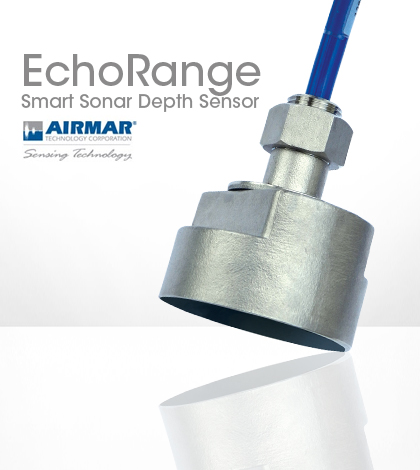Airmar’s EchoRange Smart Sonar depth sensor: Unprecedented customization

Airmar EchoRange Smart Sonat Depth Sensor
Airmar’s EchoRange SS510 Smart Sonar depth sensor is a useful instrument for hydrographic surveys, bridge scour monitoring and dredging projects. It features a sturdy construction, standard serial output and integrated temperature sensor.
The EchoRange’s inner circuitry is housed in a steel body. “316 stainless steel is very durable and resistant to corrosion,” said Paul Strawbridge, product manager. “This material is very commonly used with our transducer housings.”
Sensor cabling is contained in a thermoplastic rubber that protects wiring from environmental factors, like ozone, as well as oil and chemicals. Strawbridge says thermoplastic rubber is flexible and has good abrasion resistance.
The sensor is overall very durable, with minimal maintenance concerns and no necessary calibration. The only real concern is occasionally cleaning off the sensor face. “The acoustic window may need to be cleaned from time to time. It’s all dependent on where the transducer is employed, the environment it’s in, and how long it stays in water,” said Strawbridge.
If biofouling is an issue, Strawbridge suggests using water-based transducer paint on the acoustic window to prevent it. These paints commonly contain a biocide that discourages marine organisms from growing.
The EchoRange has a solid construction and its inner circuitry adds to its utility. The depth sensor features several standard outputs for data transmission. The sensor may be connected to a laptop or tablet PC with a serial port for use in mobile surveys.
“The sensor itself is quite small. The unit is less than five pounds in weight,” said Strawbridge.
The EchoRange can also output data via RS485 for interfacing with Airmar’s File Viewer software, which shows detailed echo envelope data.
“The echo envelope consists of 900 points from the echo amplitude. This information is transmitted via RS485 and may be displayed as an analog waveform using File Viewer that we provide for free,” said Strawbridge. “By analyzing the shape of the echo envelope, information indicative of the seafloor type can be revealed.” File Viewer is mostly used by equipment manufacturers who develop their own readout display electronics, says Strawbridge.
With an integrated temperature sensor, the EchoRange includes a small addition that some users could need. Though Strawbridge hasn’t seen many customers use it, he says building it in doesn’t add much to production cost and it’s worthwhile having because some applications could benefit from temperature data.
“I honestly don’t know of any other similar product on the market to compare to the Echo Range,” said Strawbridge. “If there was, I’m willing to bet they wouldn’t allow users to customize the product as we do.”
This customization includes sending commands to the EchoRange to change settings like baud rate, speed of sound through water, temperature and depth offsets, ping repetition rates and controlling sentence transmission.





0 comments